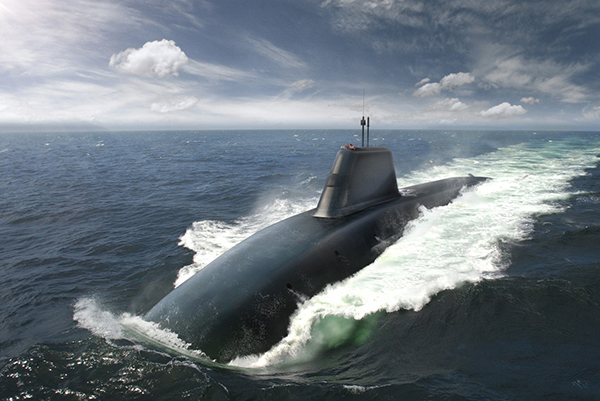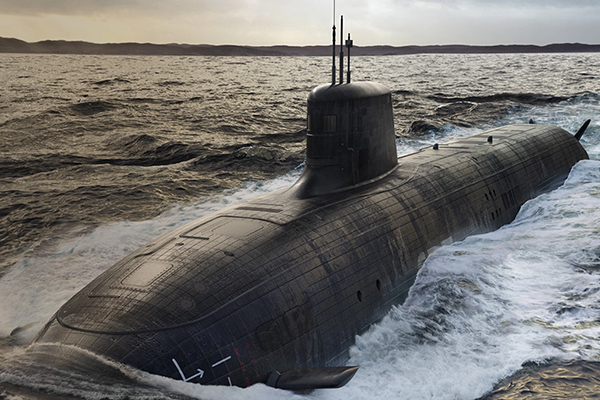UK and international submarine programmes offer significant opportunities for nuclear-ready manufacturers.
Rolls-Royce has produced and maintained the nuclear power systems for the UK submarine fleet for more than 60 years, and is now preparing to provide the reactors for a new generation of ships including Australia’s first nuclear-powered submarines.
UK programme
Rolls-Royce provides reactors and associated components for the UK’s current Astute and Dreadnought submarine programmes, and provides frontline support for the Royal Navy’s operational fleet.
The Royal Navy operates two types of submarine, known as SSN and SSBN.
SSN (submersible ship nuclear) refers to nuclear-powered attack submarines which carry weapons such as heavy torpedoes and cruise missiles. SSN submarines include the UK’s former Trafalgar fleet (seven boats, of which one remains in operation) and its Astute replacement (five boats now in service, with another two in construction).
SSBN refers to the heavier submarines which carry ballistic nuclear weapons. The UK currently operates four Vanguard SSBNs carrying Trident missiles as part of the continuous at-sea deterrant (CASD). These will be replaced by four new Dreadnought submarines, with the first due to enter service in the early 2030s.

Construction of the Dreadnought fleet is managed by the Dreadnought Alliance, a collaboration between the Ministry of Defence (MOD), BAE Systems and Rolls-Royce. The programme is budgeted at £31 billion with a £10 million contingency fund, and involves around 2,500 suppliers across the UK.
Overall responsibility for the UK submarine programme sits with the Submarine Delivery Agency, an executive agency of the MOD.
Australia-UK-US partnership
Under a trilateral agreement signed by Australia, the UK and US in March 2023, the UK and Australia will both build new nuclear-powered submarines to a UK design known as SSN-AUKUS or SSN-A. The nuclear power plants for both fleets will be manufactured by Rolls-Royce in Derby, with BAE Systems leading construction of the submarines.
AUKUS (pronounced as a word, and also often written as Aukus) is the name given to an extensive military partnership between the three countries, announced in September 2021 to counter growing Chinese influence in the Indo-Pacific region. The submarine collaboration is just one of two core parts (or pillars) of the agreement: the second pillar covers other joint military capabilities including uncrewed undersea vessels, cybersecurity, artificial intelligence, electronic warfare and hypersonic missiles.

Construction of the UK’s SSN-A submarines will be based in Barrow-in-Furness, with the first ships delivered in the late 2030s to replace the Astute fleet. Following two initial design contracts worth £85 million each with Rolls-Royce and BAE Systems in September 2021, the MOD announced a further £4 billion of contracts with the two companies and Babcock in October 2023.
Australia is now building up its submarine industrial base to construct five SSN-A boats at the Osborne Naval Shipyard in Adelaide, South Australia, with the first scheduled to enter service in the early 2040s. Construction will be led by a partnership between BAE Systems and Australia’s ASC. Some components including the power system will be manufactured in the UK.
The programme will be led by the new Australian Submarine Agency, created in July 2023. For more information on industrial opportunities, visit the industry portal at ICN Gateway.
For the latest on developments in South Australia, visit Defence SA.
As an interim measure, Australia will also acquire at least three Virginia-class nuclear-powered submarines from the US in the early 2030s.
Under the international nuclear non-proliferation treaty, the Australian submarines will not carry nuclear weapons.
Submarine reactors
While technical details remain highly confidential, Rolls-Royce’s submarine nuclear power plants are based on pressurised water reactor (PWR) technology.
Also referred to as nuclear steam raising plant (NSRP), these submarine reactors work on the same basic principles as the PWRs used in current civil nuclear power plant, but on a much smaller scale and under very different operating conditions.
Astute submarines are powered by Rolls-Royce’s PWR2 reactor, originally developed for the Trafalgar fleet, and fuelled by highly-enriched uranium. The latest PWR2 design can operate for around 30 years without refuelling.
The Dreadnought fleet will be powered by the new PWR3 reactor, which is adapted from a US design with UK reactor technology and secondary systems. The PWR3 uses a passive cooling system, and is considered safer than previous designs.
The power source for SSN-A is yet to be confirmed.
Jobs and skills
The UK government says that the multilateral submarine programme will create thousands of jobs in the UK in the decades ahead. The workforce in Barrow-in-Furness is expected to increase from 10,000 to 17,000 to meet demand from both Dreadnought and SSN-A, with further roles created along the supply chain.
Rolls-Royce’s Derby-based submarines business currently employs more than 4,000 people. It is now using investment from the MOD and Australian government to increase production of nuclear power plants, almost doubling the size of its Raynesway site and creating an estimated 1,170 new jobs in manufacturing, engineering and other roles.
To provide a pipeline of talent into the submarines business, Rolls-Royce and the University of Derby opened the Nuclear Skills Academy in 2022 to provide 200 apprenticeships a year for at least a decade. The Academy was developed in partnership with organisations including the Nuclear AMRC and National College for Nuclear, with funding from the MOD and Innovate UK.
To manage the growing demand for skilled workers across both the defence and civil nuclear sectors, the MOD and Department for Energy Security & Net Zero have jointly launched a new Nuclear Skills Taskforce. In March 2024, government and industry announced a combined investment of over £760 million to create 5,000 apprenticeships and support skills development across civil and defence nuclear.
Supply chain support
The Nuclear AMRC is planning a new F4N-style supply chain programme to help Australian manufacturers secure work in the submarine programme and build links with established UK suppliers. For more information, contact Kevin Shepherd.



